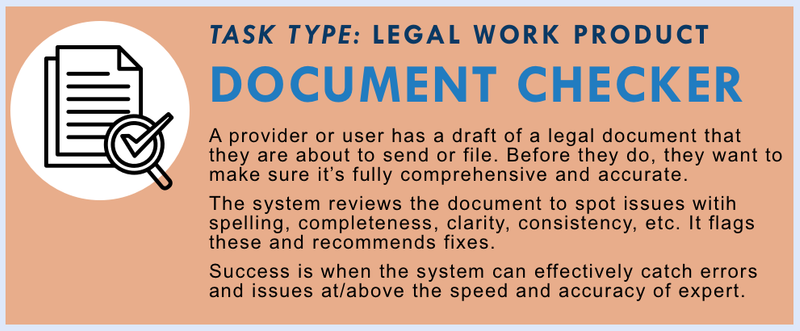Document Draft Checker

Help providers and users catch errors and gaps in drafted legal documents—ensuring they’re complete, clear, and ready to file.
Task Description
Before legal documents are filed with a court, sent to an agency, or shared with another party, they must be carefully reviewed. Even small mistakes—like typos, missing fields, inconsistent facts, or unclear phrasing—can lead to rejections, delays, or negative outcomes. Yet many users (and even professionals) are under time pressure or lack confidence in their review process.
This task focuses on a system that serves as a document proofreader and completeness checker. Whether the document is a complaint, motion, declaration, letter, or form, the system reviews it for a range of issues: spelling and grammar errors, formatting problems, incomplete fields, unclear language, logical inconsistencies, and even tone mismatches. It then flags these issues and offers suggested edits or clarifications.
The system is context-aware—it understands that legal documents have specific conventions, such as defined terms, citation rules, procedural structures, and jurisdiction-specific formatting. It can tailor its review based on the document’s purpose and destination (e.g., filing with a housing court vs. submitting to a benefits agency).
This task is especially useful for self-represented litigants preparing paperwork, legal aid providers working under time pressure, or community navigators assisting with form completion. It helps reduce rejected filings, miscommunications, and unnecessary follow-up.
Success means that the document is free from avoidable mistakes, includes all required parts, and communicates clearly and credibly—at a level that matches or exceeds what a seasoned legal professional would catch.
How to Measure Quality?
🔠 Spelling, Grammar, and Formatting
- Flags typos, punctuation errors, and improper capitalization
- Checks for consistent formatting across headings, numbered items, and citations
- Identifies incorrect use of legal terms or commonly confused phrases
✅ Completeness and Field Validation
- Detects missing fields, unanswered prompts, or incomplete attachments
- Checks that key elements (e.g., date, signature, case number) are included
- Warns if required supporting documents are not referenced or attached
🔍 Clarity and Readability
- Flags overly complex or ambiguous sentences
- Suggests plain-language rewrites for user-facing documents
- Warns about vague requests or unclear facts
🔁 Consistency and Logical Coherence
- Checks consistency of names, dates, facts, and terminology throughout the document
- Flags discrepancies between what is claimed in different sections
- Detects broken references (e.g., “see section below” with no matching section)
⚖️ Context-Aware Legal Review
- Adjusts review based on document type and purpose (e.g., declaration vs. motion)
- Understands typical document structure for specific jurisdictions or agencies
- Avoids overcorrection or irrelevant grammar fixes that would change legal meaning
⏱️ Efficiency and Review Support
- Reduces time required for human proofreading or QA
- Outputs a flagged markup or annotated preview with inline suggestions
- Tracks acceptance/rejection of suggestions for training and future improvement